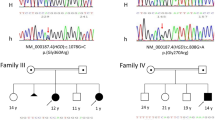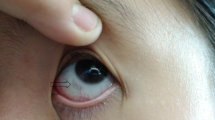Abstract
Alkaptonuria (AKU) occupies a unique place in the history of human genetics because it was the first disease to be interpreted as a mendelian recessive trait by Garrod in 1902. Alkaptonuria is a rare metabolic disorder resulting from loss of homogentisate 1,2 dioxygenase (HGO) activity. Affected individuals accumulate large quantities of homogentisic acid, an intermediary product of the catabolism of tyrosine and phenylalanine, which darkens the urine and deposits in connective tissues causing a debilitating arthritis. Here we report the cloning of the human HGO gene and establish that it is the AKU gene. We show that HGO maps to the same location described for AKU, illustrate that HGO harbours missense mutations that cosegregate with the disease, and provide biochemical evidence that at least one of these missense mutations is a loss–of–function mutation.
This is a preview of subscription content, access via your institution
Access options
Subscribe to this journal
Receive 12 print issues and online access
$209.00 per year
only $17.42 per issue
Buy this article
- Purchase on Springer Link
- Instant access to full article PDF
Prices may be subject to local taxes which are calculated during checkout
Similar content being viewed by others
References
O'Brien, W.M., La Du, B.N. & Bunim, J.J. Biochemical, pathological and clinical aspects of alkaptonuria, ochronosis and ochronotic arthropaty: Review of world literature (1584–1962). Am. J. Med. 34, 813–838 (1963).
La Du, B.N., Zannoni, V.G., Laster, L. & Seegmiller, J.E. The nature of the defect in tyrosine metabolism in alcaptonuria. J. Biol. Chem. 230, 251–260 (1958).
Garrod, A.E. The incidence of alkaptonuria: a study in clinical individuality. Lancet 2, 1616–1620 (1902).
Garrod, A.E., The Croonian Lectures on inborn errors of metabolism Lecture II. Alkaptonuria. Lancef 2, 73–79 (1908).
Pollak, M.R. et al. Homozygosity mapping of the gene for alkaptonuria to chromosome 3q2. Nature Genet. 5, 201–204 (1993).
Janocha, J. et al. The human gene for alkaptonuria (AKU) maps to chromosome 3q. Genomics 19, 5–8 (1994).
Montagutelli, X. et al. aku, a mutation of the mouse homologous to human alkaptonuria maps to chromosome 16. Genomics 19, 9–11 (1994).
Schmidt, S.R., Müller, C.R. & Kress, W. Murine liver homogentisate 1,2-dioxygenase. Purification to homogeneity and novel biochemical properties. Eur. J. Biochem. 228, 425–430 (1995).
Fernández-Cañón, J.M. & Peñalva, M. A. Fungal metabolic model for human type I hereditary tyrosinaemia. Proc. Natl. Acad. Sci. USA 92, 9132–9136 (1995).
Fernández-Cañón, J.M. & Peñalva, M. A. Molecular characterization of a gene encoding a homogentisate dioxygenase from Aspergillus idulans and identification of its human and plant homologues. J. Biol. Chem. 270, 21199–21205 (1995).
Zannoni, V.G., Seegmiller, J.E. & La Du, B. N. Nature of the defect in alkaptonuria. Nature 193, 952–953 (1962).
Srsen, S. Akaptonuria (Osveta Publishers, Martin [in Slovak], (1984).
Srsen, S., Srsnova, K. & Lanyi, A. Clinical manifestation of alkaptonuria in relation to age [in Slovak]. Bratis. Lek. Listy 77, 662–669 (1982).
Srsen, S., Vondracek, J., Srsnova, K. & Svac, J. Analysis of the life span of alkaptonuric patients [in Slovak]. Cas. Lek. Ces. 124, 1288–1291 (1985).
Zannoni, V.G., Lomtevas, N. & Goldfinger, S. Oxidation of homogentisic acid to ochronotic pigment in connective tissue. Biochim. Biophys. Acta 177, 94–105 (1969).
Wolf, J.A. et al. Effects of ascorbic acid in alkaptonuria: alterations in benzoquinone acetic acid and an ontogenic effect in infancy. Pediatr. Res. 26, 140–144 (1989).
Levine, M. New concepts in the biology and biochemistry of ascorbic acid. N. Engl. J. Med. 314, 892–902 (1986).
Kamoun, P., Coudé, M., Forest, M., Montagutelli, X. & Guénet, J. L. Ascorbic acid and alkaptonuria. Eur. J. Pediatr. 151, 149 (1992).
Roth, M. & Felgenhauer, W. R. Recherche de I'excrétion d'acide homogentisique urinarie chez des hétérozygotes pour I'alcaptonurie. Enzym. Biol. Clin. 9, 53–58 (1968).
Fernández-Ruiz, E. et al. Mapping of the human VLA-a4 gene to chromosome 2q31-q32. Eur.J.Immunol. 22, 587–590 (1992).
Author information
Authors and Affiliations
Rights and permissions
About this article
Cite this article
Fernández-Cañón, J., Granadino, B., De Bernabé, D. et al. The molecular basis of alkaptonuria. Nat Genet 14, 19–24 (1996). https://doi.org/10.1038/ng0996-19
Received:
Accepted:
Issue Date:
DOI: https://doi.org/10.1038/ng0996-19
This article is cited by
-
Breakpoints characterisation of the genomic deletions identified by MLPA in alkaptonuria patients
European Journal of Human Genetics (2023)
-
Ochronotic arthropathy in the context of spondyloarthritis differential diagnosis: a case-based review
Rheumatology International (2022)
-
Bone fragility in patients affected by congenital diseases non skeletal in origin
Orphanet Journal of Rare Diseases (2021)
-
Family history of ochronotic arthropathy
Rheumatology International (2021)
-
Founder effects of the homogentisate 1,2-dioxygenase (HGD) gene in a gypsy population and mutation spectrum in the gene among alkaptonuria patients from India
Clinical Rheumatology (2020)



